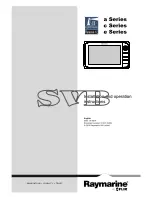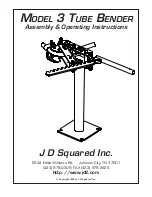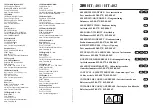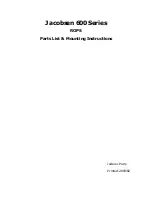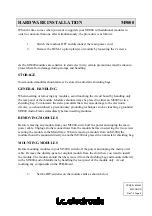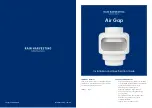
COMPATIBILITY
This acoustic device is only compatible with conventional control panels and systems, unless an approved optional module is fitted. For more
specific information regarding compatibility refer to your fire security system supplier and the technical documentation concerning the control
panel in use.
INSTALLATION - IMPORTANT NOTES
Refer to national and international standards in use for spacing and positioning of the fire security’s system devices; refer also to specific
standards and your supplier if the system is going to be installed in particular environments or environments where specific risks exist.
This device is to be used only with conventional control panels and systems (check the COMPATIBILITY paragraph).
This device must be wired according to the connection details described in this manual.
Disconnect the sounder line from the control panel before installing this device.
Test the device after installation.
SOUNDER OPENING PROCEDURE
In order to detach the upper sounder body from the base:
1) Insert the pins of the compatible key into the holes of one of the two side locking mechanisms.
2) Turn the key 90° to the left whilst applying light pressure.
3) Repeat this step for the second side locking mechanism; the locking mechanism appears as in picture 1 when
in the open position (flush).
4) Detach the sounder body from the base by pulling gently to separate (picture 3).
SOUNDER CLOSING PROCEDURE
In order to assemble the sounder body to the base:
1) Assemble the sounder body to the base using gentle pressure (picture 3).
2) Insert the pins of the compatible key into the holes of one of the two side locking mechanisms.
3) Turn the key 90° to the right.
4) Repeat this step for the second side locking mechanism, starting from point 2; the locking mechanism ap-
pears as in picture 2 once closed (recessed).
5) To secure use the retaining screws, using the location holes on both sides of the base (picture 4).
Picture 1
Picture 2
ARGUS SECURITY S.R.L.
- Via del Canneto, 14 - 34015 - Muggia (TS) - Italy
www.argussecurity.it
CWS100-AV
CONVENTIONAL WALL S VISUAL ALARM DEVICE
Picture 3
928y/01
Picture 4
OUTDOORS AND DAMP ENVIRONMENTS INSTALLATION
When installing the sounder outdoors or in a damp environment, carefully apply the self-adhesive
sealing pad to the back of the sounder base (picture 5).
WALL INSTALLATION
1) Choose the installation location for the sounder based upon system design regulations.
2) Fix the sounder base to the wall; the prepared location options for the fixing screws are highlighted in picture 6.
CABLE ENTRIES
The sounder base is provided with a knockout entry for the system cables, located in the centre of the base (picture 7).
The side wall of the base has prepared drilling points to allow for installation of cable glands; a row of three drilling points are provided to allow
for single or twin cable connection (picture 8).
TERMINAL BLOCKS INSTALLATION
The terminal block on the back of the sounder body is installed as illustrated in picture 9.
L20-CWSVX-0001 (vA.
3
)
LL
Picture 6
Picture 7
Picture 8
Picture 9
Picture 5
EN 54-3
Type B -
approved for
outdoor use.
WIRING
Connect the sounder to the sounder circuit from the control panel; wiring terminal connections are as illustrated in picture 10 and described in
table 1; an example of a typical circuit wiring arrangement is shown in picture 11.
ARGUS SECURITY S.R.L.
- Via del Canneto, 14 - 34015 - Muggia (TS) - Italy
www.argussecurity.it
P
o
s
T
o
n
e
A
lt
Picture 10
Table 1
Terminal block number
Terminal block designation
Notes
Usage
1
Pos
Terminal blocks for the line’s positive terminals
(+). These block are shorted: either one can be
used.
Connect to the positive terminals of the
control panel’s sounder circuit.
2
3
Tone
Terminal blocks for the line’s negative terminals
(-). These block are shorted: either one can be
used.
Connect to the negative terminals of
the control panel’s sounder circuit.
Wiring to these terminal blocks acti-
4
5
Alt
Terminal blocks for the line’s negative terminals
(-). These block are shorted: either one can be
used.
Connect to the negative terminals of
the control panel’s sounder circuit.
Wiring to these terminal blocks acti-
6
Sounder line (+)
Sounder line (-)
Picture 11
Use of the Tone or Alt terminals enable, respectively, the main tone set or the alternate one; refer to the MAIN TONE SET
and the ALTERNATE TONE SET paragraphs.
The sounder line must
be capable of providing
a surge/power-up cur-
rent of at least 2 times
the sum of the indicated current
of all the AV devices on the line
itself.
The sounder line must be capable
of providing a steady state cur-
rent of at least 1.5 times the sum
of the alarm currents of all the AV
devices on the line itself.
OUTPUT TONE SETTING
Use the DIP switch on the back of the sounder body to select the tone required; for this function the first five switches are used, highlighted in
picture 12.
The switches positioned upwards acquire value “1”; on the other hand, if positioned downwards acquire value “0”.
1) From the MAIN TONE SET table or the ALTERNATE TONE SET table (the choice of the table depends on how the sounder’s wiring has
been carried out) select the output alarm tone triggered when the sounder is activated.
2) Refer to the corresponding line of the “DIP configuration” column to select the five switch selection settings.
OUTPUT VOLUME SETTING
Use the DIP switch at the back of the sounder body to select the output volume; in particular, switches 6 and 7, highlighted in picture 13, are
used.
The switches positioned upwards acquire value “1”; on the other hand, if positioned downwards acquire value “0”.
1) Select the alarm volume required when the sounder is activated (table 2).
2) Refer to the corresponding line of the “DIP configuration” column to set the two volume selection switches.
Picture 12
Picture 13
L20-CWSVX-0001 (vA.
3
)
LL
Tone volume
DIP configuration - switch 6 and 7
dB(A) evaluation
Notes
HIGH
11
100 dB(A) +/- 3
All tones
MEDIUM HIGH
01
MEDIUM LOW
10
LOW
00
Table 2



